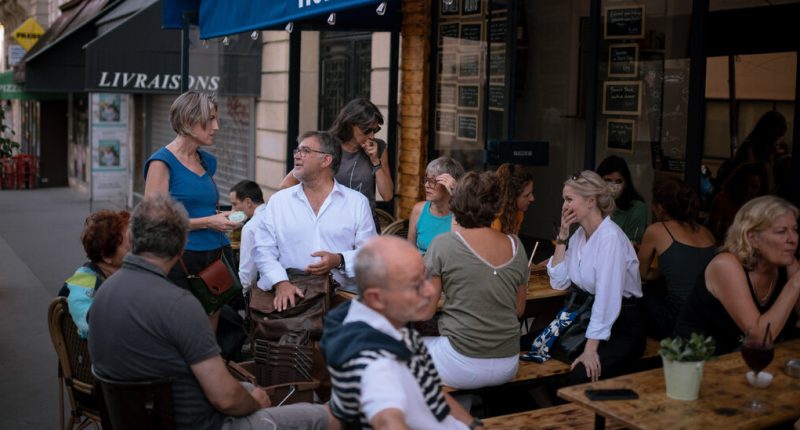
A series about how cities transform, and the effect of that on everyday life.
As the sky began to tint lemon-yellow one evening last month, 50 or so Parisians marched along to the Rue de l’Aude in the south of the city and gathered in a nautically themed loft space filled with chairs.
Some of the attendees were already close friends or acquaintances; some had spied one another on the street on a handful of occasions. For others it was the first time they had ever met. Yet all had fulfilled their entry requirement: to bring cheese.
“I took a wheel of Époisses because my wife is from that region,” one attendee, Benjamin Dard, said in reference to a famously pungent and unctuous cow’s milk variety from Burgundy.
“Everyone bought something else that related to them, in a way paying homage to the diversity of France,” Mr. Dard said. Mentioning a former French president, he added, “It’s like de Gaulle said: ‘How can you govern a country where there are 300 different kinds of cheese?’”
The meet-up, known as the Talking Cheese — which combines a smorgasbord of dairy goods with talks by local residents on their subjects of expertise — is one of a dizzying galaxy of activities run by the Republic of Super Neighbors, a grass-roots initiative whose territory spans about 50 streets in the 14th arrondissement, a largely residential district on the Seine’s Left Bank.
More than 1,200 of these so-called Super Neighbors communicate via 40 WhatsApp groups dedicated to queries like finding a cat sitter or seeking help to fix broken appliances. They hold weekly brunches, post-work drinks and community gatherings at which older residents share memories with younger generations. To much fanfare, the group also hosts an annual banquet — La Table d’Aude — for the residents on a table 400 meters long, about 440 yards, running through the middle of a street.
Started in 2017, the hyperlocal experiment is the brainchild of Patrick Bernard, a local resident and former journalist, who argues that the functioning of cities can be radically improved if urban policy drills down to “the most local entity in a city.”
“Urban strategy must focus on these microneighborhoods, or three-minute villages, as I like to call them,” said Mr. Bernard, who estimates that Paris could house 150 of these urban villages based on its population and geography. “Conviviality is a richness that is sleeping. When we awaken the sense of place and community, the citizens and urban fabric are transformed.”
The Parisian project, whose motto is to transform neighbors who interact five times daily into those who do so 50 times a day, is at the forefront of what urban planners say is a rapidly expanding movement to reclaim cities from the ground up and to recast urban living through a hyperlocal prism of close interaction, mutual support and a sense of neighborliness.
Our immediate neighborhoods, proponents argue, are the most effective platforms by which people can create resilience to and potentially mitigate the growing number of crises that urban populations face, including loneliness, food insecurity, extreme heat and social unrest linked to inequality — as witnessed in the riots that shook Paris and other French cities this summer. In other words, they say, cities of the future must be cities of villages, public spaces and neighborhoods.
In Paris, where minority residents often say they are pushed to the margins, socially and geographically, Mr. Bernard said his intent is to leave nobody out. There are Black, Muslim and East Asian members of the Super Neighbors. Participation is free. In the past, the neighbors pooled together to pay the rent of a Malian refugee who joined them.
“Community has to be at the center of urban development,” said Ramon Marrades, the director of Placemaking Europe, a network of European organizations aiming to revitalize public spaces. “Properly inclusive policy allows residents to be actors in the community, to have a sense of anchorage and to invest emotionally.”
Much has been made of the 15-minute city, a hugely popular urban design concept centered on providing residents with all their fundamental needs within a 15-minute walk or bike ride. But the challenge lies in how to locally implement this grand vision. While the 15-minute city provides critical physical infrastructure, the three-minute city is about shaping it to the needs and characteristics of the community.
“We need to develop a process to link the two,” said Mr. Marrades, who is in the middle of a two-year collaboration with 15 European cities including Helsinki, Finland, and Cork, Ireland, to embed hyperlocality and community-building in the core of urban policies.
Many cities around the world are riffing on this theme of hyperlocality. Barcelona is creating 503 Superblocks — 400-by-400-meter microneighborhoods focused on community projects, green space and mobility — across the city. Throughout Sweden, a plan for one-minute cities aims to make all streets “healthy, sustainable and vibrant” by 2030, deploying things like movable street furniture. In pilot stages, this led to people in cities, including Stockholm, spending 400 percent more time outside.
Other cities, like Vancouver, which was built around a streetcar grid from 1886, already have an ideal canvas for promoting neighborliness. “The hyperlocal is the solution for social resilience,” said Scot Hein, a professor at the University of British Columbia and a former urban planner for Vancouver’s City Hall. Mr. Hein envisions the city as made of 120 “community catchments,” areas that each contain a school, mixed housing and a commercial zone for shops and jobs.
Policymakers around the world are increasingly backing the hyperlocal approach. In June, U.N. Habitat, which focuses on sustainable urban development, started the Global Observatory of Sustainable Proximities to promote this urban planning model, which it describes as “a key enabler capable of fostering human well-being and effective climate action.”
Back in Paris, the authorities in June voted in a new Local Urbanism Plan featuring a slew of measures aimed at strengthening neighborhoods, making it easier to open local businesses, adding more limits to short-term holiday rentals and banning “dark stores,” closed-off delivery hubs for e-commerce that critics say provide no benefits to local residents. The city’s Resilience Strategy report last year said that encouraging “neighbors to occupy and animate public spaces” could help turn “challenges of the century into opportunities.”
“Paris has made proximity the norm, even if there’s a change in mayor,” said Carlos Moreno, the Paris-based professor behind the concept of the 15-minute city, who has advised cities as diverse as Medellín, Colombia, and Dakar, Senegal. “This will allow it to be regenerated on three levels: ecological, economic and social.”
The Republic of Super Neighbors’ Talking Cheese event highlights the surprising wealth of knowledge that can be found in a neighborhood. Mr. Dard, a fact-checking and verification expert who works for the French TV channel TF1, spoke at one event about the phenomenon of fake news, and previously a neighbor spoke about working as a magistrate in a criminal court. Soon, an astrophysicist will talk about black holes.
“It’s absolutely wonderful here,” said Mr. Dard, whose neighbors recently looked after his cats and watered his plants while he was on vacation. “The ambience is unique.”
Marie-Bénédicte Loze, 37, a charity worker who moved to the area last year, lost her purse a few months ago — but it was returned by a neighbor fully intact. “The solidarity in this neighborhood is beautiful,” she said. “It’s not always like that in a city.”
But the group has loftier objectives, including health, mobility and climate. By encouraging residents to become emotionally and physically invested in public spaces they live in, Mr. Bernard argues, they will be less likely to drop trash or cigarette butts, cutting cleaning costs.
“Conviviality is an economic actor,” he said.
Collaborating with the nonprofit Les Alchimistes, the group has installed several compost bins across the neighborhood. Used by 800 Super Neighbors, they process 60 tons of organic waste a year, an abnormally high 98 percent of which has been correctly deposited. Such is the success of the project that City Hall has agreed to spend 31,000 euros, or about $34,000, to install eight more.
With support from the city’s Participatory Budget, which allows citizens to vote on municipal spending, the Republic of Super Neighbors has already revitalized a forgotten public square into a vibrant events space, and it is applying for funding to buy communal e-bike chargers and an electric cargo bike for residents to transport goods locally. In the future, the group hopes to open up a medical center geared toward local needs.
Looking further afield, the group is exploring ways in which its vision of cities carved in the image of, and powered by the bonds between, their inhabitants can be replicated and scaled up. It believes the answer is the creation of trained and paid roles — so-called Friends of the Neighborhood — to coordinate each district.
“People have begun to listen,” Mr. Bernard said. “Everyone wants their neighborhood to be like ours. Now we need to find out how to make our approach more systemic and to adapt it to the different challenges and contexts that every city in the world has.”
Source: | This article originally belongs to Nytimes.com









